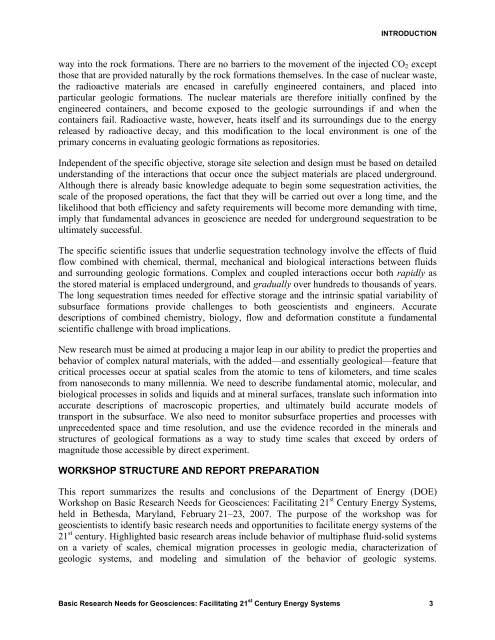Basic Research Needs for Geosciences - Energetics Meetings and ...
Basic Research Needs for Geosciences - Energetics Meetings and ...
Basic Research Needs for Geosciences - Energetics Meetings and ...
- No tags were found...
You also want an ePaper? Increase the reach of your titles
YUMPU automatically turns print PDFs into web optimized ePapers that Google loves.
INTRODUCTIONway into the rock <strong>for</strong>mations. There are no barriers to the movement of the injected CO 2 exceptthose that are provided naturally by the rock <strong>for</strong>mations themselves. In the case of nuclear waste,the radioactive materials are encased in carefully engineered containers, <strong>and</strong> placed intoparticular geologic <strong>for</strong>mations. The nuclear materials are there<strong>for</strong>e initially confined by theengineered containers, <strong>and</strong> become exposed to the geologic surroundings if <strong>and</strong> when thecontainers fail. Radioactive waste, however, heats itself <strong>and</strong> its surroundings due to the energyreleased by radioactive decay, <strong>and</strong> this modification to the local environment is one of theprimary concerns in evaluating geologic <strong>for</strong>mations as repositories.Independent of the specific objective, storage site selection <strong>and</strong> design must be based on detailedunderst<strong>and</strong>ing of the interactions that occur once the subject materials are placed underground.Although there is already basic knowledge adequate to begin some sequestration activities, thescale of the proposed operations, the fact that they will be carried out over a long time, <strong>and</strong> thelikelihood that both efficiency <strong>and</strong> safety requirements will become more dem<strong>and</strong>ing with time,imply that fundamental advances in geoscience are needed <strong>for</strong> underground sequestration to beultimately successful.The specific scientific issues that underlie sequestration technology involve the effects of fluidflow combined with chemical, thermal, mechanical <strong>and</strong> biological interactions between fluids<strong>and</strong> surrounding geologic <strong>for</strong>mations. Complex <strong>and</strong> coupled interactions occur both rapidly asthe stored material is emplaced underground, <strong>and</strong> gradually over hundreds to thous<strong>and</strong>s of years.The long sequestration times needed <strong>for</strong> effective storage <strong>and</strong> the intrinsic spatial variability ofsubsurface <strong>for</strong>mations provide challenges to both geoscientists <strong>and</strong> engineers. Accuratedescriptions of combined chemistry, biology, flow <strong>and</strong> de<strong>for</strong>mation constitute a fundamentalscientific challenge with broad implications.New research must be aimed at producing a major leap in our ability to predict the properties <strong>and</strong>behavior of complex natural materials, with the added—<strong>and</strong> essentially geological—feature thatcritical processes occur at spatial scales from the atomic to tens of kilometers, <strong>and</strong> time scalesfrom nanoseconds to many millennia. We need to describe fundamental atomic, molecular, <strong>and</strong>biological processes in solids <strong>and</strong> liquids <strong>and</strong> at mineral surfaces, translate such in<strong>for</strong>mation intoaccurate descriptions of macroscopic properties, <strong>and</strong> ultimately build accurate models oftransport in the subsurface. We also need to monitor subsurface properties <strong>and</strong> processes withunprecedented space <strong>and</strong> time resolution, <strong>and</strong> use the evidence recorded in the minerals <strong>and</strong>structures of geological <strong>for</strong>mations as a way to study time scales that exceed by orders ofmagnitude those accessible by direct experiment.WORKSHOP STRUCTURE AND REPORT PREPARATIONThis report summarizes the results <strong>and</strong> conclusions of the Department of Energy (DOE)Workshop on <strong>Basic</strong> <strong>Research</strong> <strong>Needs</strong> <strong>for</strong> <strong>Geosciences</strong>: Facilitating 21 st Century Energy Systems,held in Bethesda, Maryl<strong>and</strong>, February 21–23, 2007. The purpose of the workshop was <strong>for</strong>geoscientists to identify basic research needs <strong>and</strong> opportunities to facilitate energy systems of the21 st century. Highlighted basic research areas include behavior of multiphase fluid-solid systemson a variety of scales, chemical migration processes in geologic media, characterization ofgeologic systems, <strong>and</strong> modeling <strong>and</strong> simulation of the behavior of geologic systems.<strong>Basic</strong> <strong>Research</strong> <strong>Needs</strong> <strong>for</strong> <strong>Geosciences</strong>: Facilitating 21 st Century Energy Systems 3
















